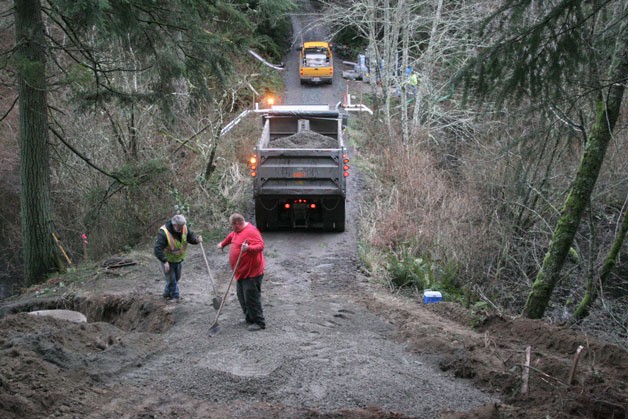Around-the-clock emergency pumping in the upper Glendale Creek area near Clinton has all but ended the most recent flood threat to Glendale Beach, Island County Public Works Director Bill Oakes said Thursday.
Oakes said the water levels on both sides of private Frog Water Road, which had increased to more than 32 million gallons this month because of a collapsed culvert, have dropped more than two feet since the county began pumping Wednesday, Jan. 5.
He said the county would quit pumping on Friday, or today at the latest, after a new 24-inch-diameter culvert is installed under the road.
“This will eliminate the danger of the road overtopping, which is the reason we got involved,” Oakes said.
He said water surging over the road would have overwhelmed two beaver dams downstream, and caused more potential flooding for the tiny beach community of Glendale.
In April 2009, Glendale residents were forced to flee after a collapsed beaver dam sent a wall of water and debris down Glendale Creek, wiping out a section of Glendale Road and crashing to the beach, causing millions of dollars in damage.
This time around, water had backed up since November behind Frog Water Road after the creek culvert under it failed. The water all ended up on private land, but the county intervened at the direction of the state Department of Ecology, which declared the situation an emergency.
As a precaution, county engineers also stockpiled sandbags at lower Glendale for use by residents in case the stream overflowed, and monitored the stream level daily.
The large wetlands complex upstream is on private property near Cultus Bay and French roads. The amount of water at peak accumulation — the largest level on record — can be represented by a pond 20 acres wide and 5 feet deep, Oakes said.
When pumping ends, the county will leave the pumps in place for the time being, to make sure the new system performs as expected, he said.
Throughout the week, county crews have been assisted by two gravity-flow syphons installed earlier by property owners, and by two beaver dams that helped hold the water downstream, minimizing the pressure on the road from the water backing up behind it.
Misguided attempts by persons unknown to breach the beaver dams —- dynamite was suspected in one case — were quickly repaired by the beavers, Oakes said.
“The beaver dams held up fairly well,” he said.
Oakes said the cost to the county would probably include more than $30,000 for the pumping operation and another $20,000 for the new culvert.
“This fix should last for quite a while,” he said. “It’s up to the property owners if they want to do anything more.”
Craig Williams, president of Friends of Glendale, a group of about 50 residents in the watershed, said upper Glendale Creek residents would continue to monitor the wetlands to determine the effects of the new water flow.
“I think we’ve all learned by getting a better understanding of the system and how it functions,” he said Thursday.
Williams said his own road, Deer Field Lane, which at peak accumulation was more then two feet under water, is now “high and dry.” He and his neighbors, Edward and Mikki Osterberg, had been forced to walk or take a tractor around the flooded area to get to their cars.
“We can see our road again, which is good,” Mikki Osterberg said Thursday. “We still can’t drive on it until the first part of next week, but that’s a dream come true for me at this point.”
Williams said residents of the area are pleased with the county’s efforts, and even provided coffee, cookies and shelter for crew members manning the pumps 24 hours a day during inclement weather this past week.
“Everybody pulled together and did an incredible job,” he said.
As for the beavers, Williams said the animals have put up their dams along a two-mile stretch of the creek in a deep ravine.
“We never had any worries about the beaver dams,” he said. “They don’t have any impact on people’s land use.
“Besides, they’re beneficial to the ecosystem, because they create habitat for other species,” he continued. “And they slow the water going down to Glendale, and that’s a good thing.”
Williams said regular updates on the water are posted on his group’s website, www.friendsofglendale.org.



